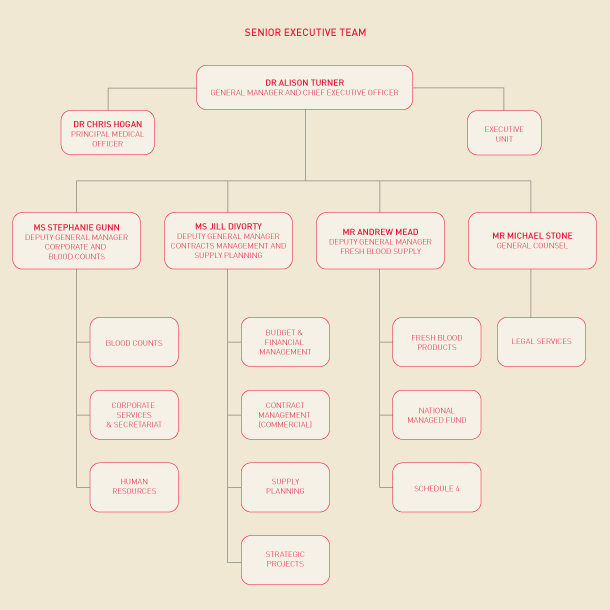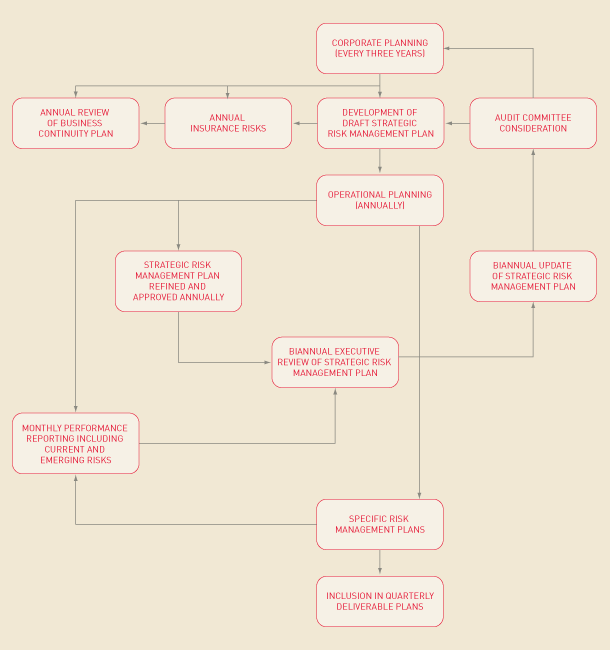

At 30 June 2009 the executive management of the National Blood Authority comprised the following staff:
Figure 4.1 shows the NBA’s organisational structure.
FIGURE 4.1 NBA’s Organisational structure


Staff celebrating NBA’s 5th birthday.
Mr Michael Stone is the NBA’s General Counsel. He has extensive experience in providing legal advice and services for a wide range of Australian government agencies, in the fields of commercial and public law, agency governance and accountability, and the development and implementation of legislation and administrative schemes.
Mr Stone practised for eight years with the Australian Government Solicitor, including as an outposted in-house lawyer for a number of clients. He joined the Legal Services Branch of the Department of Health and Ageing to work on a range of significant ‘blood’ matters—including development of the National Blood Agreement and establishment of the NBA.
Mr Stone has worked with the NBA since its inception in 2003.
Ms Jill Divorty oversees the establishment and management of commercial contracts and supply planning for plasma-derived and recombinant blood products. She is the Relationship Manager for the commercial suppliers, among them CSL Ltd, Baxter Healthcare Pty Ltd, Octapharma Australia Pty Ltd, Novo Nordisk Pharmaceuticals Pty Ltd and Wyeth Australia Pty Ltd.
Ms Divorty joined the Australian Public Service in 1996 and came to the NBA from Defence Housing Australia. She has senior management experience in finance and accounting, planning, procurement and project and program management. She is a certified practising accountant and holds an MBA. She is currently undertaking doctoral studies in business administration.
Ms Divorty joined the NBA in August 2008, replacing Mr Leigh McJames, who took leave from the NBA at that time and resigned on 1 July 2009.
Ms Stephanie Gunn is the NBA’s Corporate and Blood Counts Manager and provides leadership to NBA projects driving appropriateness of use. She has qualifications in economics and extensive experience in program and project management associated with the analysis of regional and industry development. Ms Gunn joined the Department of Health and Ageing in 1996, working in the Minister’s Office, and then moved to senior management roles in Ageing and Community Care and Corporate Management, focusing on corporate governance, procurement and planning.
Ms Gunn joined the NBA in November 2003.
Mr Andrew Mead is the NBA Contract and Relationship Manager for Fresh Blood Supply-Australian Red Cross Blood Service. He has qualifications in health services management and nursing. Before joining the NBA, he was responsible for risk management and audit at the Australian National University. Previous positions held include General Manager of Griffith Base Hospital and Albury Base Hospital. Over the past 27 years Andrew has worked in various administrative and clinical roles in the acute health care setting, including tertiary referral and regional and rural hospitals. He has also held academic appointments at Charles Stuart University in health management and paediatrics, including the delivery of health service management development programs in Indonesia.
Mr Mead joined the NBA in July 2008, replacing Mr Gordon Lee Koo, who left the NBA in May 2008.
Ms Jennifer Morison FCA, FCPA, FAIM, is the chair of the Audit Committee. She is a chartered accountant with 27 years of broad experience in the profession and in commerce. Her career has included audit, taxation, management consulting, corporate advisory work, and consulting to government. She is a leading consultant in the area of public sector financial management reform in Australia and is an independent member and chair of Commonwealth and ACT government audit and risk committees.
Ms Morison was appointed Chair of the NBA’s Audit Committee in 2007, having been a member of the Committee since 2004.
The NBA has three formal governance committees. During 2008–09 a number of changes were made to the governance framework to increase the focus of the NBA executive on planning for and managing core strategic projects and stakeholder concerns. These changes were implemented progressively during 2009 with particular focus on:
The Senior Executive Managers Committee is the NBA’s primary policy and process decision-making body, and it supports the General Manager in matters relating to risk, compliance, stakeholder management, ethics and governance of the NBA. The Committee meets three times a month. During 2008–09 the Committee:

The Executive Managers Committee is designed to focus on performance reporting and improvement and meets monthly. It is responsible for:
The role of the Audit Committee is to provide expert advice to the General Manager on the need for, and strategies to enhance, the organisation’s control framework, to improve the objectivity and reliability of externally published financial information, and to comply with legislative requirements and obligations. The Committee met six times in 2008–09, and its membership was:
Representatives from the Australian National Audit Office and the NBA’s internal auditors also attend as observers for most matters.
The Senior Executive Managers Committee considers the Audit Committee minutes and any findings from internal and other audits in order to confirm prioritisation and resourcing for any recommended changes or improvements.
Effective implementation of our governance framework is integral to the NBA’s overall planning and risk management framework. Figure 4.2 shows the process used to determine and monitor risks and operational activities.
FIGURE 4.2 How the NBA manages risk

| Risk description | Actions implemented |
|---|---|
Suboptimal outcomes for the blood sector due to lack of integration with the wider health sector |
|
Failure to use NBA internal capacities and processes to ensure an efficient organisation that can maintain capacity, skills and knowledge, even when staff depart |
|
Inability to ensure supply of fresh blood products due to poor contract negotiation or contract management |
|
Inability to ensure supply of fresh blood components due to default or corporate failure by the Australian Red Cross Blood Service |
|
Potential infection due to a new blood-borne disease |
|
Inadequate resources to perform NBA legislative functions |
|
Inability to meet financial liabilities |
|
Inability to ensure supply of plasma-derived and recombinant products due to poor contract negotiation or contract management |
|
Serious non-compliance with government procurement arrangements (breach of the Financial Management and Accountability Act 1997) |
|
NBA or officers’ actions or inactions lead to criminal or civil charges |
|
Inadequate IT systems or support for work of NBA |
|
This framework integrates risk considerations into all planning activities and ensures:
The major risks to the NBA, against which actions were implemented during the year are summarised in Table 4.1.
Participation in the 2009 Comcover Risk Management Benchmarking Program has resulted in an increase in our benchmarked score from 6.7 out of a possible 10 in 2008 to 7.2 in 2009. This score retains the NBA at the level of ‘comprehensive’, which indicates a high level of competency in implementing an enterprise-wide risk management framework. The remaining key area identified by the survey for improvement in 2009–10 is monitoring and review.
The comprehensiveness of our approach to business continuity planning was acknowledged though multiple references to our practices in the latest Australian National Audit Office Business continuity plan best practice guide.
A key element of ensuring appropriate risk management is the NBA’s internal audit program, guided by the Audit Committee. In 2008–09 the agreed program of audits focused on reviewing and analysing performance against key operational and financial risks, including payroll and leave management and procurement processes for non-blood goods and services. The negative findings resulting from these internal audits were minimal and were addressed by minor refinements to the NBA’s key business processes. During the reporting year the Audit Committee focused on exploring the adequacy of mechanisms to ensure compliance with relevant legislation and regulatory requirements. A number of presentations on our internal monitoring and assessment processes were provided to the Audit Committee, and a new checklist was developed and will now be reported on at regular intervals.
The Audit Committee accepted that the proposed 2007–10 Internal Audit Plan be delayed to allow for the appointment of new internal audit services through a tender process. The tender resulted in the appointment of Walterturnbull Pty Ltd for three years. The internal auditor will commence work in mid-July 2009 by undertaking a risk threat assessment.
There was sound progress with the Audit Committee’s work program during 2008–09. Activities included:
The Audit Committee provided valuable advice on the implementation of the fraud control plan. Key initiatives included:

The NBA’s legal counsel Michael Stone.
The existing contract for fraud control services expired in early 2008, requiring the NBA to undertake a procurement exercise for fraud risk assessment and training services for the next three years. This assessment resulted in the development of a new fraud control plan, as required by the Commonwealth guidelines on fraud control.
The findings of the assessment were that the overall fraud risk of the NBA was ‘low’, with a universally strong control environment in operation. No significant gaps were identified in the NBA’s fraud controls. From this assessment and as a result of our continual monitoring of accountability and control frameworks, the NBA has met the specific needs of the agency and complies with the Commonwealth Fraud Control Guidelines.
No instances of fraud were detected during the reporting year.
The NBA acknowledges the assistance provided by its external auditors, the Australian National Audit Office, in 2008–09. This enabled the NBA to provide assurance of compliance and appropriate accountability and to identify scope for continual improvement in our activities.
There was no formal external scrutiny of the NBA in 2008–09.